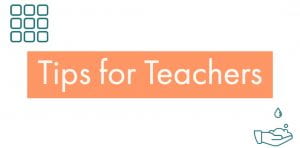
Reality of an ESL Teacher
It has been 49 days since I saw my students and coworkers. I chose to dedicate my life to helping my students achieve and develop into young adults. I never predicted that the last trimester of my second year of teaching would be online.
As I spend my days waiting for my students to send a message or join Google Meet, I also reminisce about how long I have known some of these students. I am a second year teacher, but I have been working at the same school for four years. I was a field experience student, teacher candidate, long-call substitute, summer school teacher, and finally full time. With four years at the same school, I have known most of my eighth graders since they were sixth graders. There is one student in particular that stands out from that group because he says, “We go way back.” He’s right. We do go way back. We met during my first field experience placement when he was in fourth grade. I have had the privilege of watching this student grow up, learn another language, and develop into the jokester we always knew he was. I am saddened to think I will not hear him brag about how long he has known me and I am disappointed they are all missing out on the Spring Fling and other end of the year celebrations.
I miss instructing my students and being able to see and hear their progress. I miss our silly conversations about their lives and how they are too invested in my wedding plans. Even when this pandemic ends, life will never be the same. They have missed out on major moments in their childhoods and as a teacher, I have missed out on helping them get there. There are many things I wish I could have known before becoming a teacher. There are many things I still have to learn myself, but the least I can do for you today is share what I do know. It is time for us to talk about what it is really like to be a teacher of ESL. Today my goal is to debunk some of the myths that go along with teaching ESL and give you more of an insight to the reality of this profession.
Five Myths About Teaching ESL
ESL teachers need to speak the language(s) of their students.
 I cannot count how many times I have been asked if I was fluent in the languages my students speak. If I was, I would be fluent in English, Somali, Arabic, Spanish, and Creole. Don’t get me wrong. Teaching my diverse group would be much easier with a stronger background with their languages. To bridge the gap between languages, I have put an emphasis on learning phrases and keywords in each language, as well as becoming familiar with their cultural traditions. This simple gesture goes a long way in building strong, respectful relationships with students.
I cannot count how many times I have been asked if I was fluent in the languages my students speak. If I was, I would be fluent in English, Somali, Arabic, Spanish, and Creole. Don’t get me wrong. Teaching my diverse group would be much easier with a stronger background with their languages. To bridge the gap between languages, I have put an emphasis on learning phrases and keywords in each language, as well as becoming familiar with their cultural traditions. This simple gesture goes a long way in building strong, respectful relationships with students.
Your job will be fulfilling EVERYDAY.
As much as we want to have amazing days everyday, it is impossible. We can strive for great days, great lessons, and great attitudes; and manage to survive a chaotic day, failed lesson, or bad attitude. During my teacher candidacy, my cooperating teacher would say, “Let’s chalk it up as a fail and do better tomorrow.” She knew not every lesson or class would go right, which made teaching that much better. We cannot put high expectations on every aspect of our teaching. We need to leave room for adjustments and be willing to start from the beginning when necessary.
Teaching only happens in the classroom.
 Distance learning, e-learning, and traditional learning are all forms of teaching we have become more familiar with during this time. Most people believe teaching only happens in the classroom and students will not learn outside of their regular learning environment. Some of my students have checked out for the year because they do not want to learn from a distance. Others are thriving because they are able to get the help they need from instructional videos and tutorials. It is possible for learning to happen outside of the physical classroom, but it takes time to develop online classroom routines, expectations, and management procedures.
Distance learning, e-learning, and traditional learning are all forms of teaching we have become more familiar with during this time. Most people believe teaching only happens in the classroom and students will not learn outside of their regular learning environment. Some of my students have checked out for the year because they do not want to learn from a distance. Others are thriving because they are able to get the help they need from instructional videos and tutorials. It is possible for learning to happen outside of the physical classroom, but it takes time to develop online classroom routines, expectations, and management procedures.
Many of my students began learning English from listening to American music, binge watching shows on Netflix with English subtitles, and making friends who are native speakers or multilingual speakers who share the same language. I really encourage my students to read novels that also have movies. This way they can have multiple opportunities to read and hear the words. Through these outside learning opportunities, they are able to interact with the language and acquire basic skills to continue working on when they get back to the classroom.
Every teacher has their own classroom.
 Wrong. As an ESL teacher, I am also required to co-teach for a portion of my day. When I first began teaching, I had three co-teachers and did not teach a class alone. It was a struggle to find a balance as a new teacher, but it only got worse when I had to ask one of the three co-teachers if I could put my desk (that I had to request from the custodial staff to find) in her room. Almost finished with my second year and I still had to find a new home for my desk back in August. I also co-teach 4/5 classes and had to find an empty classroom to house my advisory and EL Developing Reading classes. Basically, do not assume you will get your own room with a desk and a chair right away. Schools tend to have more teachers than they do classrooms, so if you plan to teach ESL prepare yourself for this possibility.
Wrong. As an ESL teacher, I am also required to co-teach for a portion of my day. When I first began teaching, I had three co-teachers and did not teach a class alone. It was a struggle to find a balance as a new teacher, but it only got worse when I had to ask one of the three co-teachers if I could put my desk (that I had to request from the custodial staff to find) in her room. Almost finished with my second year and I still had to find a new home for my desk back in August. I also co-teach 4/5 classes and had to find an empty classroom to house my advisory and EL Developing Reading classes. Basically, do not assume you will get your own room with a desk and a chair right away. Schools tend to have more teachers than they do classrooms, so if you plan to teach ESL prepare yourself for this possibility.
Anyone can teach English if they speak it.
The reality of the situation is that a lot of people think they could teach something and I admit they are not completely wrong. They might be able to teach a skill like throwing a ball, basic math, or the ABC’s, but can they manage behaviors, while differentiating a lesson for 35 students? Probably not. Teaching is not for everyone, as I am sure you know. Not everyone could handle the stress and excitement of being a teacher.
As an ESL teacher, I have experienced a lot of people saying it must be easy since I am a native speaker. Trust me, it is not easy at all. Teaching students who have various English proficiency levels and learning styles has many challenges. Currently I work with students considered level 3, meaning they are not beginners but more so intermediate. Typically, conversational speech happens quickly for many learners and reading and writing are the most difficult. Teaching someone how to read and write takes a lot of time and lots of phonics practice. Repetition is key when learning a language. Students need multiple interactions with a word before they are able to read, write, say, and hear it. This only happens when a teacher provides those opportunities throughout a lesson.
For example, to learn academic vocabulary I will read a story from the textbook to my class that contains the words they are learning. Then I will have them read with a partner or they will take turns reading aloud to the class. They are required to participate in discussions about the text and I provide them with sentence frames to encourage an academic discussion. They will also complete various writing activities to practice using the vocabulary words. These are not things every teacher is trained to provide to their students. But an ESL teacher is trained and will be able to scaffold a lesson to fit the needs of all of their diverse learners (with practice, of course).
Even though teaching ESL is not at all what I expected, I have been able to learn so much through my many experiences in the classroom. Teaching has its ups and downs like any profession, but I believe it is one of the most rewarding. We get to experience our students learning from mistakes, achieving, and establishing their personalities. If debunking one myth at a time is what it takes to encourage more people to be educators, then that is what I will do.


